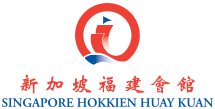Singapore Hokkien Huay Kuan
| 新加坡福建会馆 | |
 | |
| Abbreviation | SHHK |
|---|---|
| Formation | 1840 |
| Founded at | Thian Hock Keng Temple, Telok Ayer, Singapore |
| Type |
Non-Profit Organisation Clan Association Cultural & Educational Foundation |
| Headquarters | Singapore Hokkien Huay Kuan Building |
| Location |
|
| Coordinates | 1°18′57″N 103°56′18″E / 1.315935°N 103.938313°ECoordinates: 1°18′57″N 103°56′18″E / 1.315935°N 103.938313°E |
Membership (2014) | 5000+ |
Chairman | Mr Wee Cho Yaw |
Vice-Chairman | Mr Chua Thian Poh |
Board of Governors |
Mr Ong Pang Boon Mr Chng Jit Koon Mr Tay Beng Chuan Mr Chua Seng Chong |
| Website |
www |
Singapore Hokkien Huay Kuan (simplified Chinese: 新加坡福建会馆; traditional Chinese: 新加坡福建會館; pinyin: Xīnjiāpō Fújiàn Huìguǎ; Pe̍h-ōe-jī: Sin-ka-pho Hok-kiàn hōe-koán, SHHK), or the Singapore Hokkien Association in English, is a cultural and educational foundation. It was established in 1840 to promote education, social welfare and the preservation of the Chinese language and culture among Chinese Singaporean and other Overseas Chinese groups in Southeast Asia. As of 2014, the SHHK, which has 5000 members, is the largest clan association in Singapore.[1]
History
In the early 19th century, many immigrants from Fujian Province in China came to settle in Southeast Asia, including Singapore.[2] These immigrants established several clan associations to address the social needs of this immigrant community.[2] The Singapore Hokkien Huay Kuan was the first such organization to be established in 1840 on the grounds of the Thian Hock Keng Temple.[1] However, the SHHK also served other members of the Chinese community who came from other parts of China.[2]
In 1929, the philanthropist Tan Kah Kee became the president of Singapore Hokkien Huay Kuan.[3] In 1986, SHHK became one of the seven founding members of the Singapore Federation of Chinese Clan Associations. SHHK represented the interests of Singaporean Chinese speaking the Hokkien dialect, while Sam Kiang Huay Kuan catered to those from Zhejiang, Jiangsu, and Jiangxi; the Singapore Foochew Association promoted the Fuzhou dialect; the Singapore Kiung Chow Hwee Kuan to Hainanese; Singapore Kwangtung Hui Kuan to Cantonese; Singapore Nanyang Khek Community Guild defended Hakka culture; and Singapore Teo Chew Poit Ip Huay Kuan for the Teochew dialect.[4]
In 2014, the clan moved its headquarters from Telok Ayer Street, where it had been based at for 174 years, to the former premises of Changkat Changi Secondary School.[1] Its new headquarters also houses the SHHK-run pre-school and a cultural centre.[1]
Educational projects
The SHHK is actively involved in the education scene in Singapore since its founding.[5] It established its first school, Tao Nan School in 1906.[6] Subsequently, it established Ai Tong School in 1912, Chong Hock Girls' School (now known as Chongfu Primary School in 1915), Nan Chiau High School and Primary School in 1947 and Kong Hwa School in 1953.[6] As these 6 schools continue to remain affiliated to the Singapore Hokkien Huay Kuan, these schools emphasizes on the teaching of Chinese culture and values.[5] The schools are all highly regarded by Singaporeans.[5]
The SHHK also donated land for the construction of the Nanyang University (now National University of Singapore[7]) campus in 1955.[6] In 2010, the clan also set up a pre-school with an emphasis on Chinese and bilingual education.[8]
In support of promoting Chinese literary writing and raise the standard of Chinese Language in Singapore, the SHHK Literacy Awards were established since 2003 as an amalgamation of the SHHK Primary Schools Chinese Essay Writing Competition (since 1984), National Secondary School Chinese Creative Writing Competition – Xin Lei Jiang (since 2003), as well as the Singapore Tertiary Chinese Literary Awards(since 2002), which SHHK is the main sponsor.
Religious projects
SHHK manages the operations of four Singapore temples:
- Thian Hock Keng Temple
- Goh Cho Tua Peh Kong Temple
- Kim Lan Beo
- Leng San Teng
Sources of funding
SHHK has two wholly owned real-estate development subsidiaries, Yunnan Realty Pte. Ltd. and Balestier Realty Pte. Ltd., which develop properties for sale and rental.
References
- 1 2 3 4 Weng Kam, Leong (2014-08-13). "Hokkien clan group leaves Telok Ayer Street after 174 years". The Straits Times. asiaone News. Retrieved 2015-01-06.
- 1 2 3 "Speech by President Tony Tan Keng Yam at the 7th World Fujian Convention and the 4th Singapore Hokkien Festival on 24 November 2012". President's Office, Singapore. 2012-11-12. Retrieved 2015-01-06.
- ↑ Lee, Lai To; Lee, Hock Guan (2011). Sun Yat-Sen, Nanyang and the 1911 Revolution. Institute of Southeast Asian Studies. p. 165.
- ↑ Dana, Leo Paul (2007). Handbook of Research on Ethnic Minority Entrepreneurship: A Co-Evolutionary View on Resource Management. Edward Elgar Pubilshing. p. 676.
- 1 2 3 Weng Kam, Leong (2014-04-13). "教育是福建会馆核心事业" (PDF). Lianhe Zaobao (in Chinese). National Institute of Education. Retrieved 2015-01-06.
- 1 2 3 Louise Conceicao, Jeanne (2009-04-09). "Hokkien community on Singapore Infopedia". Singapore National Library Board. Singapore Infopedia. Retrieved 2015-01-06.
- ↑ "Milestones". National University of Singapore. Archived from the original on 15 October 2007. Retrieved 11 August 2007.
- ↑ Yong Chuan, Toh (2013-09-22). "Hokkien clan body to open pre-school next year". The Straits Times. The Straits Times. Retrieved 2015-01-06.
External links
- Official website of the Singapore Hokkien Huay Kuan